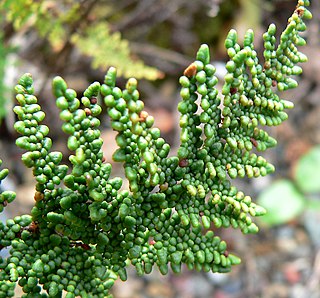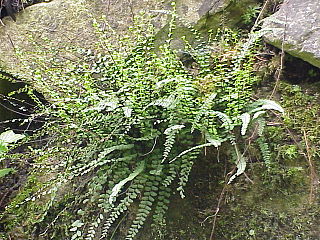
Asplenium platyneuron, commonly known as ebony spleenwort or brownstem spleenwort, is a fern native to North America east of the Rocky Mountains. It takes its common name from its dark, reddish-brown, glossy stipe and rachis, which support a once-divided, pinnate leaf. The fertile fronds, which die off in the winter, are darker green and stand upright, while the sterile fronds are evergreen and lie flat on the ground. An auricle at the base of each pinna points towards the tip of the frond. The dimorphic fronds and alternate, rather than opposite, pinnae distinguish it from the similar black-stemmed spleenwort.

Dryopteris expansa, the alpine buckler fern, northern buckler-fern or spreading wood fern, is a species of fern native to cool temperate and subarctic regions of the Northern Hemisphere, south at high altitudes in mountains to Spain and Greece in southern Europe, to Japan in eastern Asia, and to central California in North America. The species was first described from Germany. It prefers cool, moist mixed or evergreen forests and rock crevices on alpine slopes, often growing on rotting logs and tree stumps and rocky slopes. It is characteristically riparian in nature, and is especially associated with stream banks.

Gymnocarpium dryopteris, the western oakfern, common oak fern, oak fern, or northern oak fern, is a deciduous fern of the family Cystopteridaceae. It is widespread across much of North America and Eurasia. It has been found in Canada, the United States, Greenland, China, Japan, Korea, Russia, and most of Europe.

Alsophila capensis, synonym Cyathea capensis, is a regionally widespread and highly variable species of tree fern. It is indigenous to Southern Africa and South America.

Adiantum aleuticum, the western maidenhair fern or Aleutian maidenhair, is a species of deciduous fern in the genus Adiantum.

Myriopteris clevelandii, formerly known as Cheilanthes clevelandii, is a species of lip fern known by the common name Cleveland's lip fern. It is native to southern California and Baja California in Mexico. The leaf is divided into small, bead-like segments densely covered with scales beneath. In M. clevelandii, some of these scales are reduced to hairlike structures, which help distinguish it from the closely related M. covillei. It is usually found growing on exposed rock, particularly igneous rock.

Asplenium trichomanes, the maidenhair spleenwort, is a small fern in the spleenwort genus Asplenium. It is a widespread and common species, occurring almost worldwide in a variety of rocky habitats. It is a variable fern with several subspecies.

Aspidotis densa is a species of fern in the Cheilanthoid subfamily, known by the common name Indian's dream or Serpentine fern or dense lace fern. It is native to the west coast of North America from British Columbia to California and east to the Rocky Mountains in Idaho, Montana, and Wyoming; there is a disjunct population on serpentine soils in Quebec.

Asplenium septentrionale is a species of fern known by the common names northern spleenwort and forked spleenwort. It is native to Europe, Asia and western North America, where it grows on rocks. Its long, slender leaves give it a distinctive appearance. Three subspecies exist, corresponding to a tetraploid and a diploid cytotype and their triploid hybrid.

Myriopteris gracillima, formerly known as Cheilanthes gracillima, is a species of lip fern known by the common name lace lip fern. It is native to western North America, where it grows in rocky habitat from British Columbia to California to Montana.

Amauropelta noveboracensis, the New York fern, is a perennial species of fern found throughout the eastern United States and Canada, from Louisiana to Newfoundland, but most concentrated within Appalachia and the Atlantic Northeast. New York ferns often forms spreading colonies within the forests they inhabit.

Asplenium azoricum is a fern from hybrid origin of the family Aspleniaceae, descendant of the Macaronesian ancestral fern Asplenium anceps. It lives exclusively in the Azores, that is a strict endemic Azorean fern. Its fronds are coriaceous like plastic and its rachis is very thick, dark garnet color and brilliance. A typical feature of this fern, which it shares with all the descendants of A. anceps, is the existence of a small atrium at the base of the medium and lower pinnae geared towards the apex of the frond with one or two sori in its underside.

Pellaea atropurpurea, commonly known as purple-stem cliffbrake or just purple cliffbrake, is a fern native to North and Central America. Brake is an old word for fern, related to the word bracken. Like many other members of the Pteridaceae, it is a rock plant, needing a calcareous substrate.

Pellaea calidirupium, the hot rock fern, is a fern of eastern Australia and New Zealand restricted to rocky areas in relatively arid environments. In Tasmania, where it is considered rare, it is only found on the East Coast, the Midlands, and lower slopes of the Central Plateau on dry rock faces. It is also found in Victoria and Queensland. The species was originally described from New Zealand.

Asplenium bradleyi, commonly known as Bradley's spleenwort or cliff spleenwort, is a rare epipetric fern of east-central North America. Named after Professor Frank Howe Bradley, who first collected it in Tennessee, it may be found infrequently throughout much of the Appalachian Mountains, the Ozarks, and the Ouachita Mountains, growing in small crevices on exposed sandstone cliffs. The species originated as a hybrid between mountain spleenwort and ebony spleenwort ; A. bradleyi originated when that sterile diploid hybrid underwent chromosome doubling to become a fertile tetraploid, a phenomenon known as allopolyploidy. Studies indicate that the present population of Bradley's spleenwort arose from several independent doublings of sterile diploid hybrids. A. bradleyi can also form sterile hybrids with several other spleenworts.

Polystichum lonchitis is a species of fern known by the common name northern hollyfern, or simply holly-fern. It is native to much of the Northern Hemisphere from Eurasia to Alaska to Greenland and south into mountainous central North America. It has stiff, glossy green, erect fronds and grows in moist, shady, rocky mountain habitats.

Asplenium anceps is a diploid fern of family Aspleniaceae and one of the ancestors of the ferns that form the trichomanes complex. It lives exclusively in the three northernmost archipelagoes of the Macaronesian region, that is, is an endemic macaronesian fern. Its fronds are leathery and plastic and rachis is very thick, bright reddish brown and is traversed throughout its length of three wings, two on the upper surface to draw a groove and a third on the lower surface which is characteristic and unique to this species, since all other species of the trichomanes complex without. A typical feature of this fern, which he shares with all its hybrid offspring is the existence of a small atrium on the basis of medium and less pinnae directed toward the apex of the blade with one or two sori on its underside.

Adiantum viridimontanum, commonly known as Green Mountain maidenhair fern, is a fern found only in outcrops of serpentine rock in New England and Eastern Canada. The leaf blade is cut into finger-like segments, themselves once-divided, which are borne on the outer side of a curved, dark, glossy rachis. These finger-like segments are not individual leaves, but parts of a single compound leaf. The "fingers" may be drooping or erect, depending on whether the individual fern grows in shade or sunlight. Spores are borne under false indusia at the edge of the subdivisions of the leaf, a characteristic unique to the genus Adiantum.
Asplenium × gravesii, commonly known as Graves' spleenwort, is a rare, sterile, hybrid fern, named for Edward Willis Graves (1882–1936). It is formed by the crossing of Bradley's spleenwort (A. bradleyi) with lobed spleenwort (A. pinnatifidum). It is only found where its parent species are both present; in practice, this proves to be a few scattered sites in the Appalachian Mountains, Shawnee Hills, and Ozarks, reaching perhaps its greatest local abundance around Natural Bridge State Resort Park. Like its parents, it prefers to grow in acid soil in the crevices of sandstone cliffs.

Polypodium amorphum is a species of fern with the common name irregular polypody, which grows near the northwest coast of North America.






















